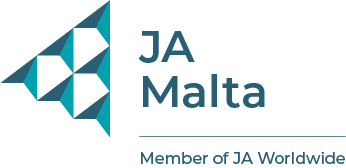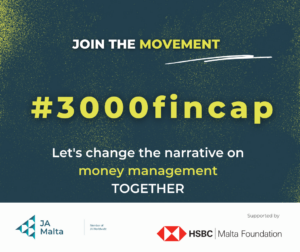Budget Apps
Here are a couple of simple budget apps that you could try out. However you need to commit to tracking your spending and noting it down. Before you realise, it soon becomes a habit, and you are more in control of how you are taking financial decisions.
Gemma Budgeting App – https://gemma.gov.mt/budget-planner-app/
YNAB – https://www.youneedabudget.com/
Spending Tracker – https://play.google.com/store/apps/details?id=com.mhriley.spendingtracker&hl=en&gl=US
50 / 30 /20 Savings Tip
The 50/30/20 saving rule is one way how you can instantly start growing your savings, and put them towards different goals E.g. Skiing holiday with friends!
SAVINGS – IMMEDIATELY 20% of your total income is to be put away and saved in a separate account DO NOT TOUCH THESE…..WATCH THEM GROW
NEEDS – 50% of your total income is to be used on your monthly expenses. These are things you have to pay for every month e.g. petrol, subscriptions.
WANTS – 30% of your total income is to be used on your Wants. This is your money to spend on you for the whole month, so you need to prioritise and think what you really need the money for.
Instant Vs Delayed Gratification
With €1.33 a day you can build up a substantial saving’s pot, PLUS get 25% back as a tax rebate from the Maltese government by starting off a private pension plan.
Its always very important to read-up before and shop around different banks and insurance companies before you take a final personal decision.
Join one of our classes on Types of Investments EXPLAINED to understand better.
Private Pensions Plans
Looking beyond our Now is an easy skill to master; even with less than €1.33 a day, you are able to maximise your money because of the asset of Time – basically, the quicker you start to deposit €1.33 a day in a private pension plan the more you can make!. The cheapest pension plan around is €40 a month. Always shop around for the best plan that fits your lifestyle and commitments.
e.g. if you are 21 years old you could put away…..Let’s do the math
€40 x 12months x 44years (till you retire at 65) = over €21,000, not including the interest you would have earnt + 25% tax rebate the government gives you for opening a private pension plan
Investment Terms & Definitions
Asset class (Definition)
An asset class is a group of financial instruments or investments that share similar characteristics and behave similarly in the market. The five main asset classes are bonds, equities, commodities, property, and cash.
Each asset class has unique features, risk and return profiles, and performance drivers.
Asset classes are important for investors because they provide a way to diversify their portfolios, manage risk, and achieve their investment objectives. By allocating their investments across different asset classes, investors can benefit from each asset class’s varying returns and risk characteristics and reduce the impact of any negative events that may occur in one particular asset class. Additionally, asset classes can help investors to align their investments with their personal goals, preferences, and risk tolerance.
Bonds:
Bonds are debt securities issued by companies, governments or municipalities. When you buy a bond, you are essentially lending money to the issuer, who promises to pay you interest on the amount borrowed over a fixed period of time, and to return the principal at the end of the bond’s term. Bonds can be issued by governments, corporations or other institutions, and their interest rate and value depend on various factors such as credit rating, inflation, and interest rate movements. Bonds are generally considered less risky than other asset classes but typically offer lower returns.
Equity:
Equity represents company ownership, which can be bought and sold on the stock market. When you own a share of stock, you have a claim on the company’s earnings and assets, and you can benefit from capital gains if the stock price rises over time. Equity investments can be very profitable, but they also carry higher risk due to market fluctuations, and there is no guarantee of returns.
Commodities:
Commodities are physical goods that can be traded on financial markets. Examples of commodities include oil, gold, silver, wheat, corn, and coffee. Commodity prices can be highly volatile due to supply and demand factors, geopolitical events, and other factors affecting production or consumption. Investors can gain exposure to commodities through commodity futures contracts or exchange-traded funds (ETFs).
Property:
Property is a physical asset class that includes real estate, land, buildings, and other tangible assets. Property investments can provide long-term capital appreciation, rental income, and diversification benefits and can also serve as a hedge against inflation. However, property investments require a large upfront investment, and they can also be illiquid and difficult to sell quickly.
Cash:
Cash is the most basic asset class and includes physical currency, bank deposits, and other liquid assets that can be easily converted to cash. Cash investments provide low returns but are generally considered safe and stable, and they can provide liquidity and capital preservation benefits. Cash investments can be used to diversify a portfolio or as a temporary safe haven during times of market volatility or economic uncertainty.
Good Debt Vs Bad Debt
Good debt and bad debt are two types of debt that individuals can take on, and they differ in their ability to add value or detract from an individual’s financial well-being over time.
Good debt is debt taken on to finance investments that can generate long-term benefits, such as increasing income or net worth. Examples of good debt include:
Student loans: Many students studying abroad may need to take out student loans to pay for their education, but this investment can increase their earning potential and provide access to better job opportunities in the future.
Mortgages: A mortgage is a long-term loan used to purchase a home. While it involves taking on debt, owning a home can provide stability, build equity, and offer tax benefits over time.
Bad debt, on the other hand, is debt that is taken on to finance purchases that do not generate long-term benefits and can negatively impact an individual’s financial situation. Examples of bad debt include:
Credit card debt: Credit card debt is high-interest debt that can quickly spiral out of control if not paid off regularly. Using credit cards to finance lifestyle purchases that are beyond one’s means can lead to a cycle of debt that is difficult to break.
Payday loans: Payday loans are short-term loans with extremely high-interest rates and fees, often used by individuals who cannot cover their living expenses. Taking out payday loans can trap people in a cycle of debt that can be very difficult to escape.
In summary, good debt can help individuals to invest in assets that generate long-term benefits, while bad debt is typically used to finance purchases that do not add long-term value and can lead to financial hardship. It is important for individuals to carefully consider their debt obligations and only take on debt that they can manage responsibly.
Check out our latest Money Management blog posts:







